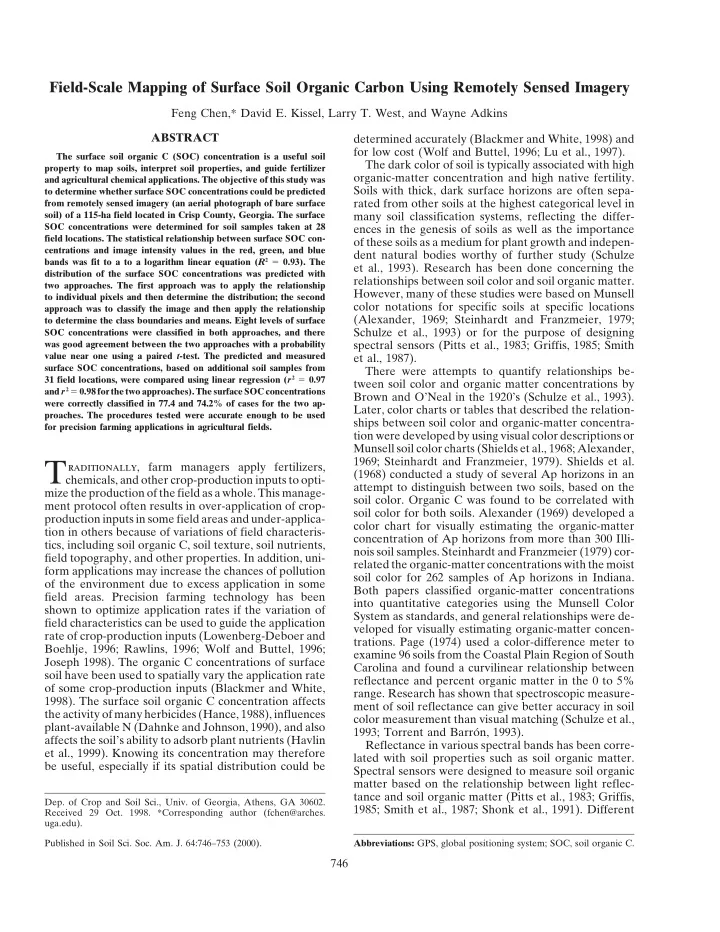

Field-Scale Mapping of Surface Soil Organic Carbon Using Remotely Sensed Imagery Feng Chen,* David E. Kissel, Larry T. West, and Wayne Adkins ABSTRACT determined accurately (Blackmer and White, 1998) and for low cost (Wolf and Buttel, 1996; Lu et al., 1997). The surface soil organic C (SOC) concentration is a useful soil The dark color of soil is typically associated with high property to map soils, interpret soil properties, and guide fertilizer organic-matter concentration and high native fertility. and agricultural chemical applications. The objective of this study was Soils with thick, dark surface horizons are often sepa- to determine whether surface SOC concentrations could be predicted rated from other soils at the highest categorical level in from remotely sensed imagery (an aerial photograph of bare surface soil) of a 115-ha field located in Crisp County, Georgia. The surface many soil classification systems, reflecting the differ- SOC concentrations were determined for soil samples taken at 28 ences in the genesis of soils as well as the importance field locations. The statistical relationship between surface SOC con- of these soils as a medium for plant growth and indepen- centrations and image intensity values in the red, green, and blue dent natural bodies worthy of further study (Schulze bands was fit to a to a logarithm linear equation ( R 2 � 0.93). The et al., 1993). Research has been done concerning the distribution of the surface SOC concentrations was predicted with relationships between soil color and soil organic matter. two approaches. The first approach was to apply the relationship However, many of these studies were based on Munsell to individual pixels and then determine the distribution; the second color notations for specific soils at specific locations approach was to classify the image and then apply the relationship (Alexander, 1969; Steinhardt and Franzmeier, 1979; to determine the class boundaries and means. Eight levels of surface Schulze et al., 1993) or for the purpose of designing SOC concentrations were classified in both approaches, and there was good agreement between the two approaches with a probability spectral sensors (Pitts et al., 1983; Griffis, 1985; Smith value near one using a paired t -test. The predicted and measured et al., 1987). surface SOC concentrations, based on additional soil samples from There were attempts to quantify relationships be- 31 field locations, were compared using linear regression ( r 2 � 0.97 tween soil color and organic matter concentrations by and r 2 � 0.98 for the two approaches). The surface SOC concentrations Brown and O’Neal in the 1920’s (Schulze et al., 1993). were correctly classified in 77.4 and 74.2% of cases for the two ap- Later, color charts or tables that described the relation- proaches. The procedures tested were accurate enough to be used ships between soil color and organic-matter concentra- for precision farming applications in agricultural fields. tion were developed by using visual color descriptions or Munsell soil color charts (Shields et al., 1968; Alexander, 1969; Steinhardt and Franzmeier, 1979). Shields et al. T raditionally, farm managers apply fertilizers, (1968) conducted a study of several Ap horizons in an chemicals, and other crop-production inputs to opti- attempt to distinguish between two soils, based on the mize the production of the field as a whole. This manage- soil color. Organic C was found to be correlated with ment protocol often results in over-application of crop- soil color for both soils. Alexander (1969) developed a production inputs in some field areas and under-applica- color chart for visually estimating the organic-matter tion in others because of variations of field characteris- concentration of Ap horizons from more than 300 Illi- tics, including soil organic C, soil texture, soil nutrients, nois soil samples. Steinhardt and Franzmeier (1979) cor- field topography, and other properties. In addition, uni- related the organic-matter concentrations with the moist form applications may increase the chances of pollution soil color for 262 samples of Ap horizons in Indiana. of the environment due to excess application in some Both papers classified organic-matter concentrations field areas. Precision farming technology has been into quantitative categories using the Munsell Color shown to optimize application rates if the variation of System as standards, and general relationships were de- field characteristics can be used to guide the application veloped for visually estimating organic-matter concen- rate of crop-production inputs (Lowenberg-Deboer and trations. Page (1974) used a color-difference meter to Boehlje, 1996; Rawlins, 1996; Wolf and Buttel, 1996; examine 96 soils from the Coastal Plain Region of South Joseph 1998). The organic C concentrations of surface Carolina and found a curvilinear relationship between soil have been used to spatially vary the application rate reflectance and percent organic matter in the 0 to 5% of some crop-production inputs (Blackmer and White, range. Research has shown that spectroscopic measure- 1998). The surface soil organic C concentration affects ment of soil reflectance can give better accuracy in soil the activity of many herbicides (Hance, 1988), influences color measurement than visual matching (Schulze et al., plant-available N (Dahnke and Johnson, 1990), and also 1993; Torrent and Barro ´n, 1993). affects the soil’s ability to adsorb plant nutrients (Havlin Reflectance in various spectral bands has been corre- et al., 1999). Knowing its concentration may therefore lated with soil properties such as soil organic matter. be useful, especially if its spatial distribution could be Spectral sensors were designed to measure soil organic matter based on the relationship between light reflec- tance and soil organic matter (Pitts et al., 1983; Griffis, Dep. of Crop and Soil Sci., Univ. of Georgia, Athens, GA 30602. 1985; Smith et al., 1987; Shonk et al., 1991). Different Received 29 Oct. 1998. *Corresponding author (fchen@arches. uga.edu). Published in Soil Sci. Soc. Am. J. 64:746–753 (2000). Abbreviations: GPS, global positioning system; SOC, soil organic C. 746
Recommend
More recommend